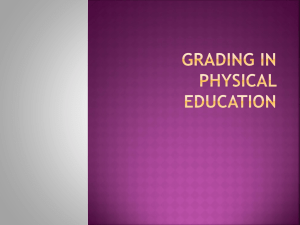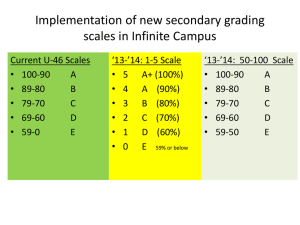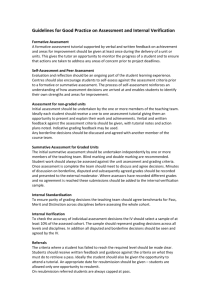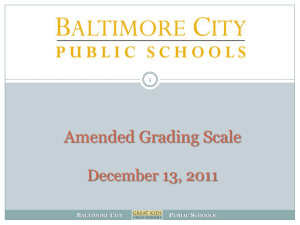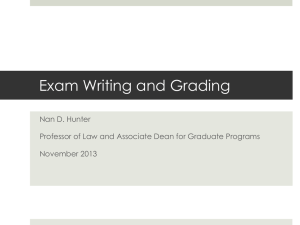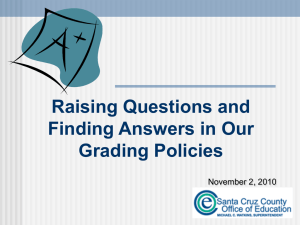Standard Based Grading Parent Presentation
advertisement
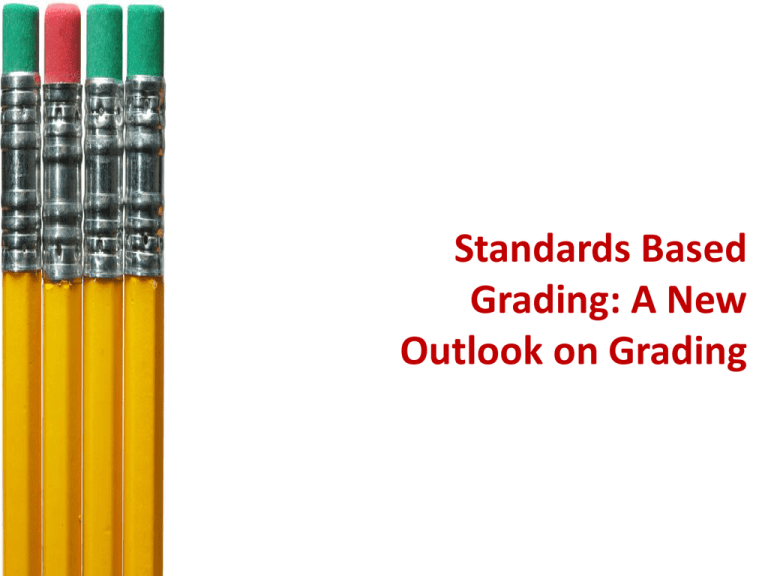
Standards Based Grading: A New Outlook on Grading “Why…would anyone want to change current grading practices?” The answer is quite simple: grades are so imprecise that they are almost meaningless.” --Robert Marzano “Grading as it has been done traditionally promotes a culture of point accumulation not learning, encourages competition not collaboration, often focuses on activities not results…and only involves assessment OF learning because everything students do gets a score and every score ends up in the grade book.” ---Ken O’Connor Traditional Grading • Letter grades-A, B, C, D, F • Academic achievement tainted by non-academic factors • Grade everything and average it together • Chronological listing of all the assignments • Report a single grade for a class Practices that Inhibit Learning • Including behaviors in academic grade • Assessments not linked to learning targets • Grading first effort (formative assessment) • Assigning Zeros as grades (The Power of Zero) • Always using the average to determine a grade • Old and recent scores are given the same weight More Traditional Grading Problems • Has a student who receives a “C” based upon 100% homework completion and 50% test average really mastered the standards? • How do grades affect the motivation of students who experience early failure and see no way to climb out of the hole they’re in? Point Chasing • Averages and Percentage Scores can be Misleading 4/9/2015 7 What is a Learning Standard? …an agreed upon statement of what a student should know and be able to do in a given content area. 4/9/2015 8 STANDARDS BASED GRADING • A focus on mastering content “standards” instead of accumulating points • A report of what students know and are able to do • A balance of formative and summative assessments (mounting evidence) • A record keeping system that informs instruction • A system that encourages student reflection and responsibility for learning SBG Principle #1 The purpose of grades is to communicate student achievement • Based on state and district standards • Academic performance only • Behaviors reported separately SBG Principle #2 A Grading Program Should • • • • Be Fair Be Consistent Support Learning Promote Communication between teachers/students/parents SBG Principle #3 Relate grading procedures to learning goals • • • • • Identify critical concepts/skills Assess individual concepts/skills Mastery is the standard Summative vs. Formative activities Multiple Opportunities to Demonstrate Learning SBG Principle #4 What should NOT be included in a grade: • • • • • • Effort Attendance Participation Citizenship Attitude Bonuses • • • • Behavior Group Work Homework Anything that doesn’t relate to a standard Real Life Applications • In real-life, attainment of important milestones (SATs, certificates, drivers’ licenses, CPA, bar exam, medical boards, etc.) allows for multiple opportunities with course corrections along the way. • Sports • Raises in the private sector Siuslaw Elementary Standards Based Report Card Characteristics of a Successful Learner Problem Solving Active Listening Independent work Uses Time Wisely Seeks Help Appropriately Participation Positive Attitude Effort & Home Practice Performance Levels * Consistently Demonstrates + Usually Demonstrates Inconsistently Demonstrates - Area of Concern Siuslaw Elementary Standards Based Report Card Eight Content Areas with Specific Learning Standards Performance Levels E M NM D X MOD 4/9/2015 Exceeds Grade Level Standard Meets Grade Level Standard Nearly Meets Grade Level Standard Does Not Meet Grade Level Standard Not Yet Taught or Assessed Modified Instruction- See Report 16 Final Thoughts




